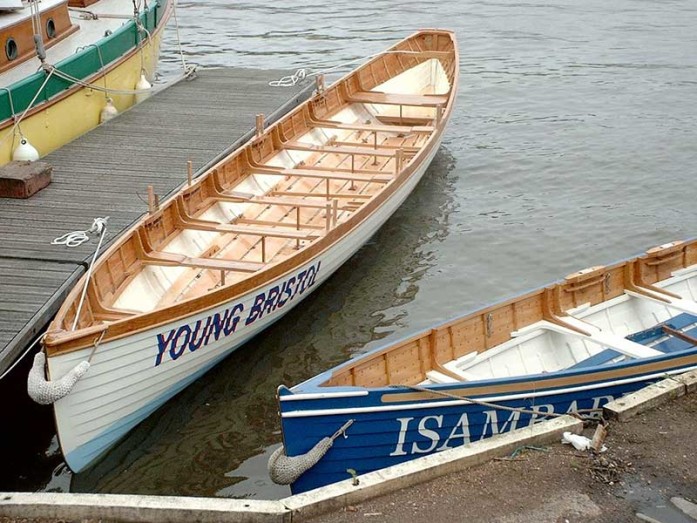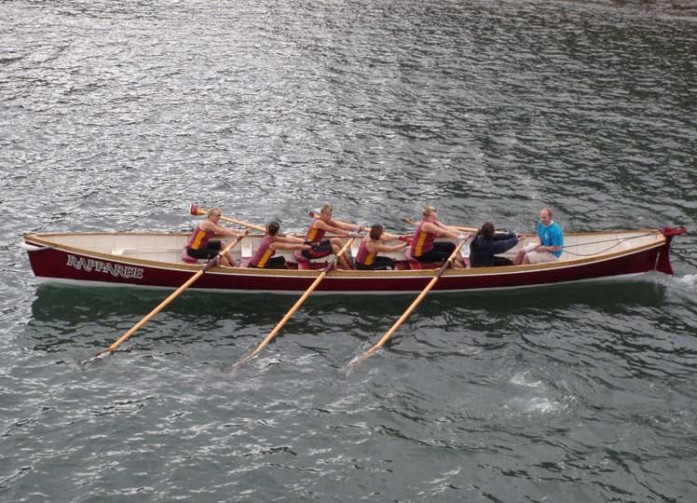A historical boat still in use today, the original purpose of the Cornish pilot gig was as a general work boat, and the craft is used for taking pilots out to incoming vessels off the Atlantic. At the time, the race would be the first gig to get their pilot on board a vessel (often those about to run aground on rocks) got the job, and hence the payment. [cf. Wikipedia]
This not very unusual floating device is a six-oared rowing boat, built of Cornish narrow leaf elm, thirty-two feet (9.8 meters) long with a beam of four feet ten inches.
It is recognized as one of the first shore-based lifeboats that went to vessels in distress, with recorded rescues going back as far as the late 17th century.

Cornish Pilot Gig
[source]
Today, pilot gigs are used primarily for sport, with around 100 clubs across the globe. The main concentration is within Cornwall and the Isles of Scilly, however clubs exist in Somerset, Devon, Dorset, Wales and London. Internationally there are pilot gig clubs in France, the Netherlands, the Faeroe Islands, Australia and the USA.
All modern racing gigs are based on the “Treffry”, built in 1838 by William Peters of St. Mawes, and still owned and raced by the Newquay Rowing Club. However non-racing gigs have been built which do not conform to the exact specification of the Treffry and are disallowed from racing in competitive races.
The sport is governed by the Cornish Pilot Gig Association, which monitors all racing gigs during the construction phase. The Association’s Standards Officer is responsible for measuring every gig at least three times during construction, to ensure that it conforms to the Standard set by the Association.
The 100th gig, built for the Bude Gig Club by Ralph Bird was launched during the summer of 2005.
Currently there are 128 gigs on the CPGA register of gigs, this does not include the Isles of Scilly. The most recent being ‘Tamar’ of the Tamar Tavy Club, but by the end of 2008 there will be 131 gigs with an additional three gigs that are currently under construction now – Ilfracombe, Lyme Regis and Mevagissey.

Cornish Pilot Gig during a race
[source]
The sport of Pilot Gig Racing has evolved over a number of years from what was once a way of earning a living. Throughout the history of the pilot gig there have been heroic rescues, jobs in pilot-ing and now the world expanding sport.
Taken from a traditional design, the gigs that are constructed today follow the original specifications as laid down by the Peters family in the form of the gig ‘Treffry’ (1838), which is still actively rowed by the Newquay Rowing Club. Over 200 years ago William Peters working in his yard at Polvarth, St. Mawes, Cornwall would have probably given little thought to the future of his craft. But for us today they are an historical asset, a testament to the skill of the Peters family. Built from narrow leaf (ideally) Cornish elm and inspected at least three times during their build by the Association Standards Officer, the modern gig is a speedy and seaworthy craft. They also have a World Championship. Since 1990, the World Pilot Gig Championships have been held annually on the Isles of Scilly
If you like what you read, please subscribe to this blog by completing the form. If you want to help more, start by following us on Twitter, and like our page on Facebook. You don’t know what good things may happen. To lighten your day, check our pins on Pinterest, we can be friends there too. Oh, and if you need a really good looking blog attached to your site, or just for fun, to express your feelings more competitively, read this Own Your Website offer! Thank you very much.
